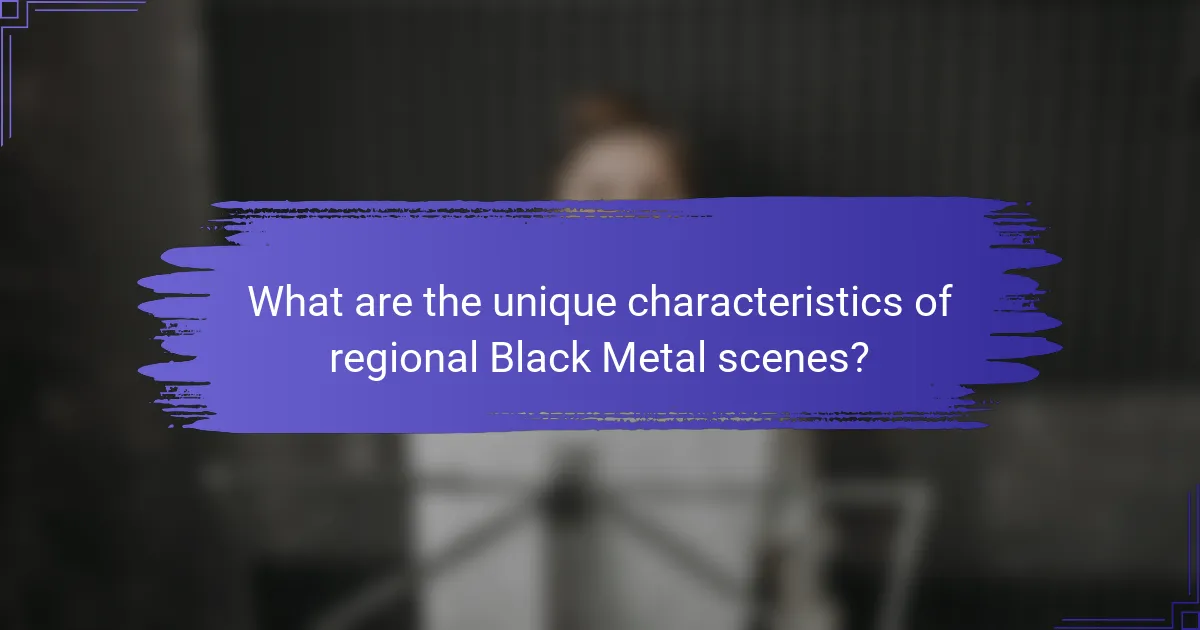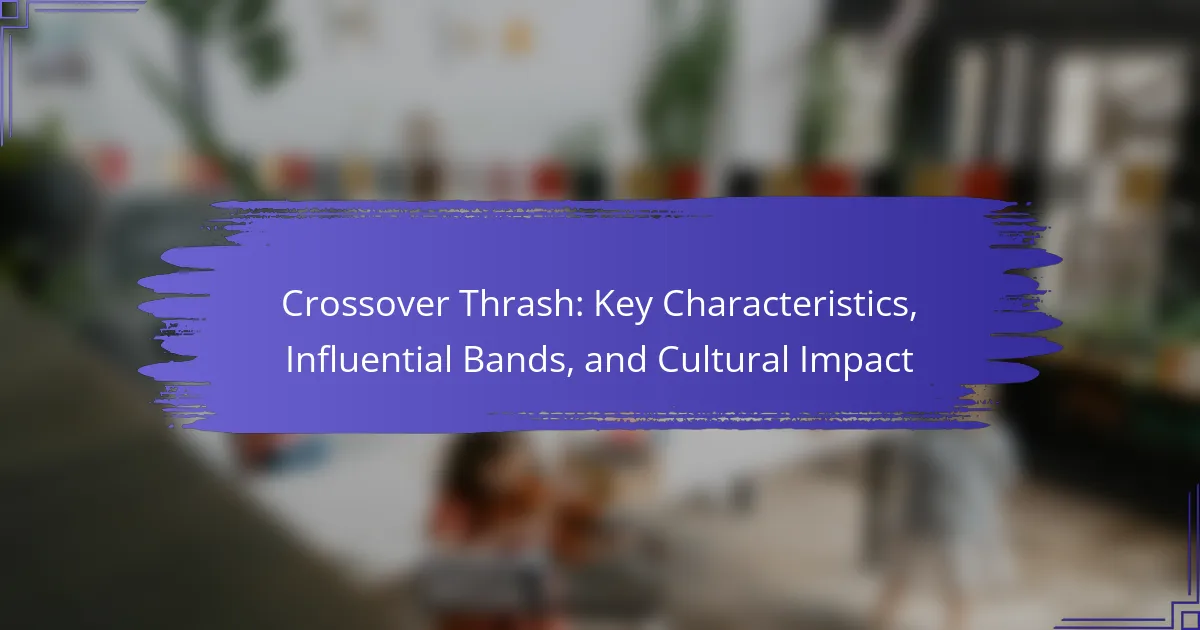Black metal is a genre defined by its themes of darkness, nature, and anti-religion. This article explores its distinctive aesthetic, including raw sound and corpse paint, and highlights pioneering groups like Mayhem and Burzum that shaped its identity. It also examines the cultural significance of folklore and mythology within the music, the unique characteristics of regional scenes, and the challenges faced by the genre today. Aspiring musicians are encouraged to embrace authenticity and explore the depth of black metal’s themes.

What are the core themes of Black Metal?
Black metal features themes of darkness, nature, and anti-religion. Its aesthetic includes raw sound, corpse paint, and atmospheric elements. Pioneering groups like Mayhem and Burzum shaped the genre’s identity, emphasizing individualism and nihilism. The music often reflects a deep connection to folklore and mythology, enhancing its cultural significance.
How do lyrical themes reflect cultural and political issues?
Lyrical themes in black metal often reflect cultural and political issues by addressing topics like anti-establishment sentiments, nature, and existential despair. Pioneering groups, such as Mayhem and Burzum, utilized their music to critique societal norms and explore personal struggles. These themes resonate with the genre’s roots in rebellion against mainstream culture, highlighting a unique attribute of black metal that distinguishes it from other genres. Additionally, the aesthetic of black metal, characterized by dark imagery and raw sound, amplifies its commentary on these issues, creating a powerful connection between music and the cultural landscape.
In what ways does nature influence Black Metal themes?
Nature profoundly influences Black Metal themes through its raw, often dark imagery and philosophical reflections. Elements such as forests, mountains, and winter landscapes evoke feelings of isolation and existential dread. Pioneering groups like Mayhem and Burzum often draw on nature’s harshness to symbolize struggle and the human condition. Additionally, nature serves as a backdrop for exploring themes of paganism and ancient traditions, connecting the music to cultural roots. This interplay enriches the genre’s aesthetic and emotional depth.
Which philosophical concepts are prevalent in Black Metal lyrics?
Philosophical concepts prevalent in Black Metal lyrics include existentialism, nihilism, and anti-Christian sentiments. These themes reflect a deep exploration of meaning, often questioning existence and societal norms. Existentialism emphasizes individual experience and freedom, while nihilism expresses a rejection of inherent meaning. Anti-Christian sentiments critique organized religion, often portraying it as oppressive. Additionally, themes of nature and paganism frequently appear, celebrating pre-Christian beliefs and the natural world. These concepts contribute to the genre’s unique aesthetic and ideological stance.

How does the aesthetic of Black Metal shape its identity?
The aesthetic of Black Metal is integral to its identity, emphasizing darkness and rebellion. This genre often features stark imagery, such as bleak landscapes and occult symbols, creating a visceral connection to themes of nihilism and anti-establishment sentiments. Pioneering groups like Mayhem and Burzum shaped this aesthetic through their album art and stage presence, often employing corpse paint and elaborate costumes. This visual style enhances the music’s emotional intensity, reinforcing the genre’s core values of individuality and defiance.
What role does visual imagery play in Black Metal branding?
Visual imagery is crucial in Black Metal branding as it conveys the genre’s dark themes and aesthetic. Iconic visuals, such as bleak landscapes and sinister artwork, establish a strong identity. This imagery often reflects the unique attributes of the genre, like its emphasis on nature and anti-establishment sentiments. Pioneering groups, such as Mayhem and Burzum, utilized striking visuals to enhance their narratives and connect with audiences. As a result, visual elements become essential in shaping perceptions and reinforcing the emotional weight of the music.
How does fashion contribute to the Black Metal subculture?
Fashion plays a crucial role in the Black Metal subculture by expressing its themes of rebellion and darkness. The aesthetic emphasizes black clothing, spikes, and corpse paint, which symbolize defiance against societal norms. This visual representation fosters a sense of identity and belonging among fans. Pioneering groups like Mayhem and Burzum have solidified these fashion elements, influencing countless followers. The unique attributes of this style, such as its raw and aggressive imagery, further distinguish it within the broader metal genre.
Which album covers exemplify the Black Metal aesthetic?
Iconic album covers that exemplify the Black Metal aesthetic include “In the Nightside Eclipse” by Emperor, “De Mysteriis Dom Sathanas” by Mayhem, and “Transilvanian Hunger” by Darkthrone. These covers often feature dark, atmospheric imagery, stark contrasts, and themes of nature and mysticism. The artwork reflects the genre’s roots in anti-establishment sentiments and a desire to evoke a sense of the otherworldly.

Who are the pioneering groups that defined Black Metal?
The pioneering groups that defined Black Metal include Venom, Mayhem, and Bathory. These bands established the genre’s core themes and aesthetic. Venom’s album “Black Metal” in 1982 coined the term, influencing countless artists. Mayhem’s theatrical performances and controversial history shaped the genre’s dark image. Bathory introduced elements of Viking mythology, expanding Black Metal’s thematic scope. Each group contributed unique attributes that solidified Black Metal’s identity in music history.
What impact did Mayhem have on the Black Metal scene?
Mayhem significantly influenced the Black Metal scene by shaping its aesthetic and themes. Their raw sound and dark imagery set a precedent for future bands. Mayhem’s infamous live performances and controversial history contributed to the genre’s mystique. Their 1987 album “De Mysteriis Dom Sathanas” is a cornerstone in Black Metal, showcasing themes of nihilism and anti-Christianity, which became defining characteristics of the genre. This album’s impact resonates through many subsequent Black Metal acts, establishing a template for musical and thematic exploration.
How did Bathory shape the sound of Black Metal?
Bathory significantly shaped the sound of Black Metal through its raw production, dark themes, and pioneering musical style. The band’s early albums, particularly “Bathory” and “Under the Sign of the Black Mark,” introduced a lo-fi aesthetic that became a hallmark of the genre. Their use of tremolo-picked guitar riffs and harsh vocals established a template for future Black Metal bands. Additionally, Bathory’s incorporation of Norse mythology and Satanic imagery added depth to the lyrical themes, influencing the genre’s overall narrative. The band’s evolution into a more epic sound in later albums further expanded the boundaries of Black Metal, merging elements of Viking Metal and creating a unique sub-genre.
Which bands are considered modern pioneers of Black Metal?
Modern pioneers of Black Metal include bands like Darkthrone, Mayhem, Immortal, and Emperor. These groups significantly shaped the genre’s sound and aesthetic, emphasizing themes of darkness and anti-establishment. Darkthrone’s raw production and Mayhem’s theatrical performances are notable contributions. Immortal’s unique visual style and Emperor’s orchestral elements further define the genre’s evolution.

How does the Black Metal community engage with its history?
The Black Metal community engages with its history through a deep reverence for its origins and influential figures. This genre often reflects themes of anti-establishment sentiments and explores dark, mythological narratives. Pioneering groups like Mayhem and Burzum are frequently referenced for their role in shaping the sound and aesthetic. Additionally, the community participates in rituals, discussions, and events that celebrate its legacy, fostering a strong sense of identity. Through this engagement, Black Metal not only preserves its history but also influences new generations of artists and fans.
What are the key events that shaped the Black Metal movement?
The Black Metal movement was shaped by key events such as the formation of pioneering bands, the emergence of a distinct aesthetic, and infamous incidents that defined its culture. The early 1980s saw bands like Venom and Bathory establish the genre’s sound and themes. The 1991 murder of Euronymous by Varg Vikernes marked a pivotal moment, highlighting the movement’s darker side. The infamous church burnings in Norway further solidified the genre’s rebellious image. These events collectively influenced the evolution and perception of Black Metal, intertwining music with a controversial cultural narrative.
How do fans preserve the legacy of influential Black Metal bands?
Fans preserve the legacy of influential Black Metal bands through dedicated communities, merchandise, and tribute events. They create online forums and social media groups to discuss music, share artwork, and promote underground artists. Merchandise sales, including vinyl records and apparel, help sustain the culture and support current musicians. Tribute events and festivals celebrate the music and influence of pioneering bands, fostering a sense of continuity and connection among fans. These efforts ensure that the themes and aesthetics of Black Metal endure and evolve within the music scene.

What are the unique characteristics of regional Black Metal scenes?
Regional Black Metal scenes exhibit unique characteristics influenced by local culture and history. These scenes often incorporate indigenous themes, folklore, and language, creating distinct sounds and aesthetics. For example, Scandinavian Black Metal emphasizes nature and mythology, while American scenes may draw from personal experiences and societal issues. Each regional scene contributes to the broader genre by adding unique attributes that reflect its cultural background.
How does Scandinavian Black Metal differ from other regions?
Scandinavian Black Metal is distinguished by its dark themes, atmospheric soundscapes, and a focus on nature and mythology. This genre often incorporates a raw production style, contrasting with the polished sound found in other regions. Pioneering groups like Mayhem and Burzum emphasize anti-Christian sentiments and personal struggles, which are less prevalent in other forms of metal. The unique aesthetic includes corpse paint and elaborate stage performances, setting it apart from Black Metal scenes in other countries.
Which local bands have gained international recognition?
Several local black metal bands have gained international recognition, including Behemoth, Dimmu Borgir, and Cradle of Filth. These groups have influenced the genre with their unique themes and aesthetics. Behemoth, for instance, is known for its blend of black and death metal, while Dimmu Borgir incorporates symphonic elements. Cradle of Filth stands out for its theatrical approach and gothic imagery. Their global tours and collaborations further solidify their status in the international metal scene.

What challenges does the Black Metal genre face today?
Black Metal faces challenges including mainstream acceptance, genre dilution, and internal conflicts. These issues threaten its authenticity and community cohesion. The rise of digital platforms has also led to oversaturation, making it difficult for underground bands to stand out. Additionally, the genre’s controversial themes often provoke backlash, which can hinder broader recognition.
How do controversies affect the perception of Black Metal?
Controversies significantly shape the perception of Black Metal by influencing its themes and aesthetic. The genre often attracts attention due to its provocative imagery and lyrical content, which can be misinterpreted. For example, the association with anti-establishment views and occult themes can lead to polarized opinions. Pioneering groups like Mayhem and Burzum have faced scrutiny, impacting how audiences engage with the music. As a result, the genre is often viewed through a lens of misunderstanding, overshadowing its artistic merits.
What role does streaming play in the evolution of Black Metal?
Streaming significantly influences the evolution of Black Metal by enhancing accessibility and fostering community. The genre benefits from platforms that allow artists to reach global audiences, breaking geographical barriers. Streaming services provide a space for niche subgenres to flourish, enabling lesser-known bands to gain recognition. This democratization of music distribution encourages experimentation and collaboration, shaping the sound and aesthetic of contemporary Black Metal. Additionally, social media integration amplifies fan engagement, creating a vibrant online culture surrounding the genre.
Which trends are emerging in the Black Metal genre?
Emerging trends in the Black Metal genre include increased incorporation of atmospheric elements, a focus on environmental themes, and the blending of genres. Artists are exploring diverse influences, resulting in innovative sounds. The aesthetic is evolving, with visual art and performance becoming more integral to the experience. Additionally, there is a growing emphasis on community and collaboration among musicians, reflecting a shift towards inclusivity in the genre.

What best practices should aspiring Black Metal musicians follow?
Aspiring Black Metal musicians should focus on authenticity, technical skill, and a strong understanding of the genre’s themes. Embrace the dark aesthetics and explore lyrical depth, drawing inspiration from nature, mythology, and personal struggles. Collaborate with like-minded artists to enhance creativity and refine your sound. Experiment with different subgenres to develop a unique style that reflects your vision. Prioritize live performances to connect with the audience and build a dedicated fan base.
How can musicians effectively build a Black Metal identity?
Musicians can effectively build a Black Metal identity by embracing its core themes, aesthetic, and influences. Key elements include dark, atmospheric music, anti-establishment lyrics, and a distinctive visual style. Pioneering groups like Mayhem and Burzum shaped the genre’s identity through their raw sound and controversial imagery, setting standards for authenticity. Incorporating these aspects helps musicians resonate with the Black Metal community and establish a unique presence.
What common mistakes should be avoided in Black Metal music production?
To avoid common mistakes in Black Metal music production, focus on clarity, atmosphere, and authenticity.
Many producers overlook the importance of maintaining a raw sound, which is essential to the genre’s aesthetic. Overproduction can dilute the emotional intensity that characterizes Black Metal. Additionally, failing to capture the intended atmosphere can result in a lack of engagement with listeners.
Balancing instrumentation is crucial; excessive layering can create a muddled mix. Ensure that each element serves the overall mood. Lastly, neglecting lyrical themes can lead to a disconnect between the music and its cultural roots, undermining the genre’s essence.



